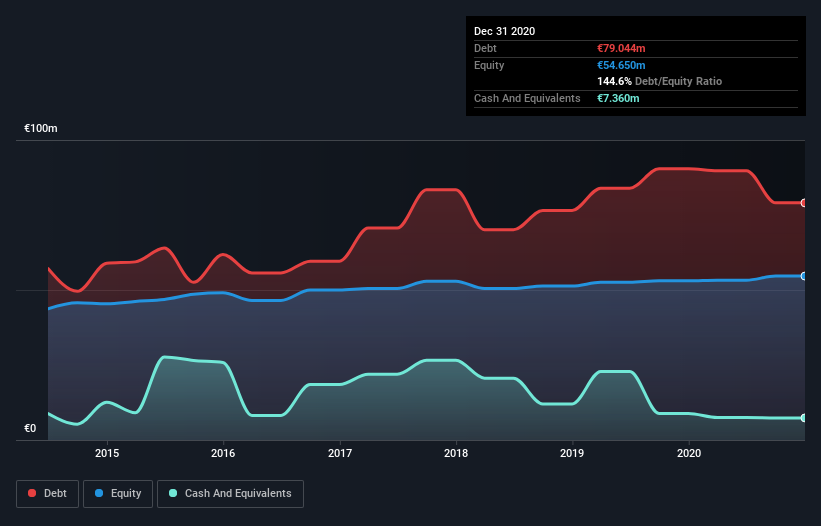- Greece
- /
- Oil and Gas
- /
- ATSE:ELIN
Does Elinoil Hellenic Petroleum (ATH:ELIN) Have A Healthy Balance Sheet?

Warren Buffett famously said, 'Volatility is far from synonymous with risk.' It's only natural to consider a company's balance sheet when you examine how risky it is, since debt is often involved when a business collapses. As with many other companies Elinoil Hellenic Petroleum Company S.A. (ATH:ELIN) makes use of debt. But the more important question is: how much risk is that debt creating?
What Risk Does Debt Bring?
Generally speaking, debt only becomes a real problem when a company can't easily pay it off, either by raising capital or with its own cash flow. If things get really bad, the lenders can take control of the business. While that is not too common, we often do see indebted companies permanently diluting shareholders because lenders force them to raise capital at a distressed price. Of course, plenty of companies use debt to fund growth, without any negative consequences. When we think about a company's use of debt, we first look at cash and debt together.
View our latest analysis for Elinoil Hellenic Petroleum
What Is Elinoil Hellenic Petroleum's Net Debt?
The image below, which you can click on for greater detail, shows that Elinoil Hellenic Petroleum had debt of €79.0m at the end of December 2020, a reduction from €90.4m over a year. However, it does have €7.36m in cash offsetting this, leading to net debt of about €71.7m.

A Look At Elinoil Hellenic Petroleum's Liabilities
Zooming in on the latest balance sheet data, we can see that Elinoil Hellenic Petroleum had liabilities of €99.0m due within 12 months and liabilities of €28.0m due beyond that. Offsetting these obligations, it had cash of €7.36m as well as receivables valued at €91.5m due within 12 months. So its liabilities outweigh the sum of its cash and (near-term) receivables by €28.2m.
Elinoil Hellenic Petroleum has a market capitalization of €49.8m, so it could very likely raise cash to ameliorate its balance sheet, if the need arose. But we definitely want to keep our eyes open to indications that its debt is bringing too much risk.
In order to size up a company's debt relative to its earnings, we calculate its net debt divided by its earnings before interest, tax, depreciation, and amortization (EBITDA) and its earnings before interest and tax (EBIT) divided by its interest expense (its interest cover). The advantage of this approach is that we take into account both the absolute quantum of debt (with net debt to EBITDA) and the actual interest expenses associated with that debt (with its interest cover ratio).
Weak interest cover of 1.9 times and a disturbingly high net debt to EBITDA ratio of 7.6 hit our confidence in Elinoil Hellenic Petroleum like a one-two punch to the gut. This means we'd consider it to have a heavy debt load. Worse, Elinoil Hellenic Petroleum's EBIT was down 28% over the last year. If earnings keep going like that over the long term, it has a snowball's chance in hell of paying off that debt. There's no doubt that we learn most about debt from the balance sheet. But it is Elinoil Hellenic Petroleum's earnings that will influence how the balance sheet holds up in the future. So if you're keen to discover more about its earnings, it might be worth checking out this graph of its long term earnings trend.
Finally, while the tax-man may adore accounting profits, lenders only accept cold hard cash. So it's worth checking how much of that EBIT is backed by free cash flow. During the last three years, Elinoil Hellenic Petroleum burned a lot of cash. While that may be a result of expenditure for growth, it does make the debt far more risky.
Our View
On the face of it, Elinoil Hellenic Petroleum's conversion of EBIT to free cash flow left us tentative about the stock, and its EBIT growth rate was no more enticing than the one empty restaurant on the busiest night of the year. And even its interest cover fails to inspire much confidence. After considering the datapoints discussed, we think Elinoil Hellenic Petroleum has too much debt. That sort of riskiness is ok for some, but it certainly doesn't float our boat. The balance sheet is clearly the area to focus on when you are analysing debt. However, not all investment risk resides within the balance sheet - far from it. These risks can be hard to spot. Every company has them, and we've spotted 4 warning signs for Elinoil Hellenic Petroleum (of which 2 are a bit unpleasant!) you should know about.
At the end of the day, it's often better to focus on companies that are free from net debt. You can access our special list of such companies (all with a track record of profit growth). It's free.
When trading stocks or any other investment, use the platform considered by many to be the Professional's Gateway to the Worlds Market, Interactive Brokers. You get the lowest-cost* trading on stocks, options, futures, forex, bonds and funds worldwide from a single integrated account. Promoted
Valuation is complex, but we're here to simplify it.
Discover if Elinoil Hellenic Petroleum might be undervalued or overvalued with our detailed analysis, featuring fair value estimates, potential risks, dividends, insider trades, and its financial condition.
Access Free AnalysisThis article by Simply Wall St is general in nature. It does not constitute a recommendation to buy or sell any stock, and does not take account of your objectives, or your financial situation. We aim to bring you long-term focused analysis driven by fundamental data. Note that our analysis may not factor in the latest price-sensitive company announcements or qualitative material. Simply Wall St has no position in any stocks mentioned.
*Interactive Brokers Rated Lowest Cost Broker by StockBrokers.com Annual Online Review 2020
Have feedback on this article? Concerned about the content? Get in touch with us directly. Alternatively, email editorial-team (at) simplywallst.com.
About ATSE:ELIN
Elinoil Hellenic Petroleum
Engages in the trading of liquid and solid fuels, and lubricants.
Solid track record with excellent balance sheet.
Market Insights
Community Narratives




